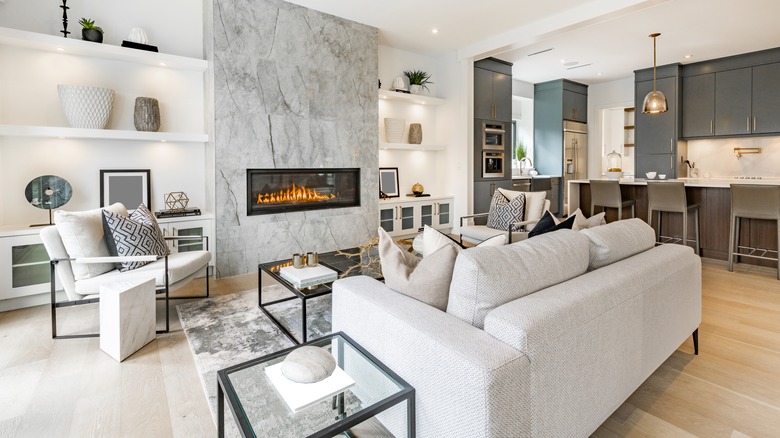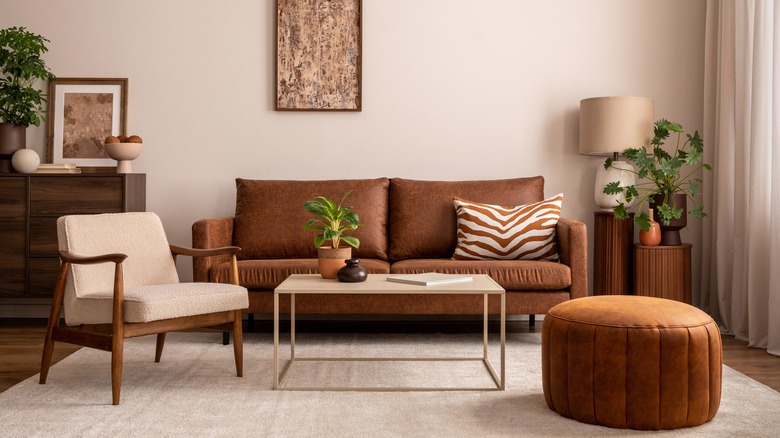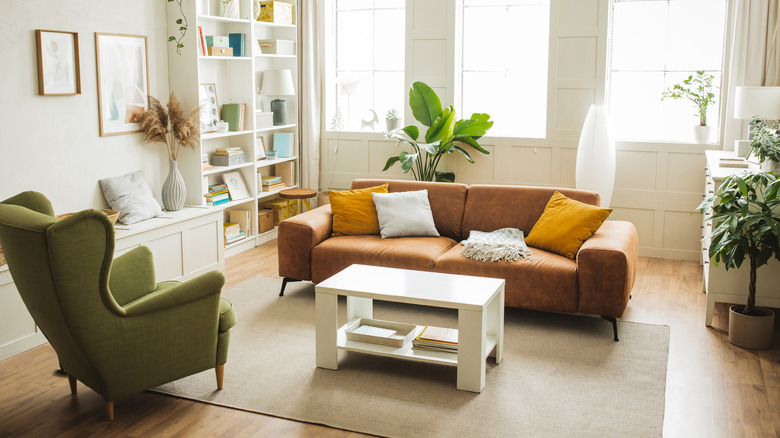How To Space Your Living Room Furniture
The living room is supposed to be one of the most comfortable rooms in your home. Of course, it's hard to feel very comfortable if you're constantly crashing your knees into the coffee table, tripping on an area rug, or lurching forward to grab the remote. Living rooms become even more tricky to style when you account for friends coming over or children needing room to play. Proper planning and spacing of furniture are key to making the room look balanced, feel comfortable, and function practically. But with so many moving parts, how should you arrange your living room furniture? In summary, there are two rules for living room layout; first, adjacent elements, like the couch and coffee table, should be of similar size and height. Second, pieces should be spaced out far enough to allow for interaction without feeling cramped or strained.
That's a complicated way to explain a living room arrangement in theory, but when you boil it down, where should you put the area rug? What's the right height for a coffee table? And where should floating chairs go? Here's how you can ensure your living room is following all the right rules while leaving room for interpretation.
Consider relative size and shape
Before you start tearing apart the living room, consider how each of your furniture pieces relates to each other in size and shape. For example, if your coffee table is significantly shorter than your couch or if your side tables sit taller than the sofa arms, you probably need to make some changes. Having a furniture set that looks and feels proportional will make arranging the room much easier, so you may want to consider investing in some new furniture pieces if you're having trouble finding the right layout.
Whether you're shopping for new furniture or assessing your current items, there are a few key rules to look out for. To make it easy to set down drinks without straining or stooping, your coffee table height should be within a few inches of the couch seat height. Next, take a look at the coffee table itself; it should have roughly half the visual weight of the sofa. A tiny coffee table will look dingy, while one that's too big will crowd the room. If you have side tables or a console table behind your sofa, they should be roughly the same height as the arms and sofa back or a few inches shorter. If you have an area rug, it should be longer than the length of the sofa and large enough to come within 12 to 18 inches of the surrounding walls.
Leave room for movement
As previously mentioned, furniture should be spaced out appropriately to allow for interaction between pieces and people. The golden rule of living rooms is to avoid blocking windows and walkways. Ideally, there should be about two to three feet of distance between large furniture pieces like the sofa, reading chairs, bookshelf, and TV stand. This way, people can easily move around the room without having to watch their toes or shimmy sideways between pieces. The coffee table is one exception to this rule; it should be close enough to reach from a seated position but remain about 16 to 18 inches away from your knees.
Arranging your living room is about more than just creating a visually balanced space; it's also important to have a room that flows and supports your daily interactions. There should be about 3 ½ to 10 feet between seating elements, which will allow people to face each other during a conversation without feeling cramped or too distant. In general, it's better to have too much empty space than too little, as the room will feel more crowded once people are in it. A living room is truly like a living, breathing space, so don't be afraid to bend or break the rules and find what works best for you.


